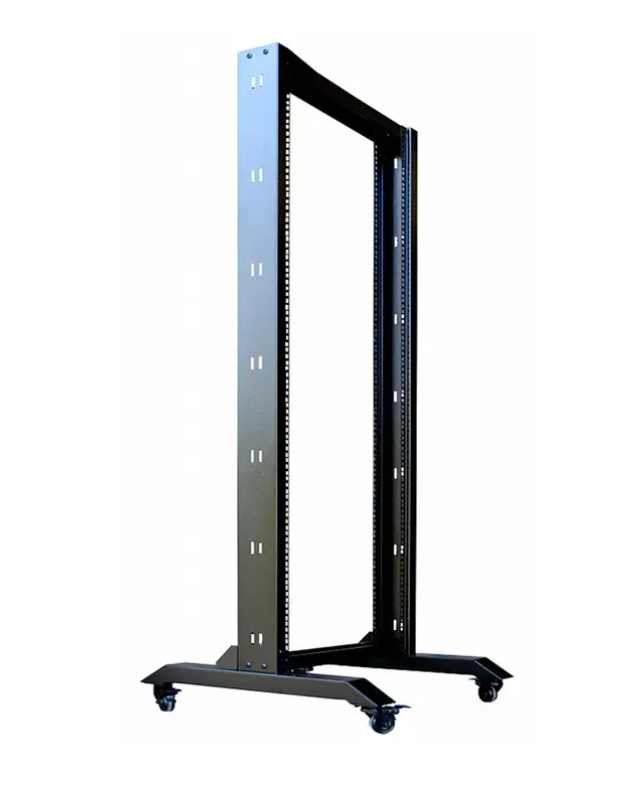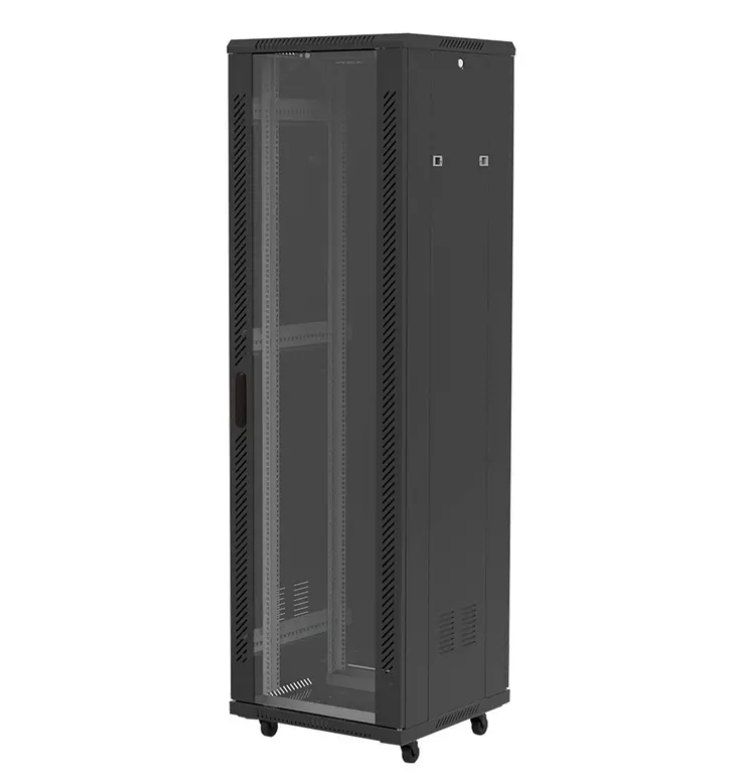Choosing the right server rack is crucial for maintaining an efficient IT infrastructure. Whether you're managing a data center or a small server room, selecting the appropriate rack can make a big difference. In this post, we'll help you decide between an Enclosed Rack and an Open Server Rack based on your needs. We'll compare their advantages, disadvantages, and ideal use cases to guide your decision-making.
What is a Server Rack?
A server rack is a frame designed to house servers and other networking equipment. It provides structure and support to keep hardware organized.
In data centers, offices, or even home networking setups, a server rack is essential. It keeps equipment safe, accessible, and well-ventilated. Without it, cables could get tangled, and hardware might be exposed to dust or accidental damage.
What is the Difference Between an Enclosed Rack and an Open Server Rack?
Enclosed Rack
An enclosed rack has side panels and doors, fully surrounding the equipment. This offers protection from dust, moisture, and unauthorized access.
Open Server Rack
An open rack, on the other hand, is just a frame. It has no side panels or doors, allowing for easy airflow. This makes it ideal for environments where cooling is a priority.
Why Does Rack Choice Matter?
Choosing the right server rack affects many aspects of your setup. Thermal management is key: an open rack provides better airflow, while an enclosed rack needs additional cooling.
Security is another factor. Enclosed racks offer better protection for your equipment. Space efficiency and cable organization also matter. The right rack ensures better system performance and longer equipment life.
Understanding Open Server Racks
What is an Open Server Rack?
An open server rack consists of 2 or 4 metal uprights, often featuring adjustable shelves. It's designed to hold networking equipment and servers securely, but without any side panels or doors.
These racks are great for environments like data centers, server rooms, or even home networking setups. They are especially useful when space is limited and cooling is a priority.
Advantages of Open Server Racks
● Cost-Effective: Since less material is needed, open racks are typically cheaper than enclosed racks.
● Improved Airflow: The open design allows air to circulate freely, helping prevent equipment from overheating.
● Accessibility: It's easy to access your servers for maintenance and monitoring, as they are not enclosed by panels or doors.
● Easy Setup: Open racks are often easier to assemble and disassemble, saving time during installation or upgrades.
Disadvantages of Open Server Racks
● Lack of Protection: Without side panels or doors, your equipment is exposed to dust, debris, and physical damage.
● Cable Management: Cables can easily become tangled or disorganized, since there are no panels to keep them in place.
● Security Concerns: Open racks don't have lockable doors, which could lead to unauthorized access or theft of sensitive equipment.
● Limited Noise Control: As open racks have no soundproofing, they may not be suitable for noise-sensitive environments, such as offices or rooms where quiet operation is needed.


Exploring Enclosed Server Racks
What is an Enclosed Server Rack?
An enclosed server rack is made of a solid body, typically featuring side panels and front and rear doors. These racks often have perforated sections for ventilation, allowing airflow while providing security.
Enclosed racks are best suited for environments where security and protection are essential. They are ideal for safeguarding equipment in sensitive areas like data centers and offices.
Advantages of Enclosed Server Racks
● Security: Lockable doors and solid construction prevent unauthorized access, offering robust protection for your equipment.
● Protection from External Factors: Enclosed racks protect servers from dust, water, and other environmental hazards.
● Cable Management: Built-in cable holes keep wires organized and prevent tangling, creating a cleaner setup.
● Noise Reduction: The solid construction helps reduce noise, making it a good choice for noise-sensitive environments.
Disadvantages of Enclosed Server Racks
● Higher Cost: More materials are required to build an enclosed rack, making it more expensive than open racks.
● Restricted Airflow: Without additional ventilation solutions, airflow can be limited, potentially causing equipment to overheat.
● Heavier and Bulkier: The solid structure makes these racks heavier and more challenging to transport.
● Maintenance Complexity: It can be harder to access equipment in an enclosed rack, complicating maintenance or upgrades.

Which Rack Should You Choose?
Factors to Consider When Choosing a Server Rack
Airflow and Cooling Needs
Open racks are ideal for environments where there is strong natural airflow. They allow air to circulate freely around the equipment, reducing the risk of overheating. This makes them perfect for server rooms that prioritize cooling without extra measures.
Enclosed racks, on the other hand, have solid walls that limit airflow. To keep equipment cool in an enclosed rack, additional cooling solutions are necessary, such as fans, air conditioning, or exhaust systems. Without these, the risk of heat buildup can increase, potentially damaging your hardware.
Security Concerns
If your servers contain sensitive data, or if unauthorized access could lead to potential security risks, an enclosed rack is a better choice. These racks come with lockable doors, offering a layer of protection against physical threats.
Open racks do not provide the same level of security, as they have no enclosures to prevent unauthorized access. If physical security is important to your setup, you may need to combine an open rack with other security measures, such as camera monitoring or access control systems.
Space Efficiency
Open racks are typically more compact and can fit in tighter spaces. They are a great choice for small or crowded server rooms where space is at a premium. Their open-frame design uses less material, which also means they take up less room.
In contrast, enclosed racks tend to be bulkier due to their solid construction. They require more space for installation and may not fit well in smaller rooms. However, they offer better organization and protection, which may justify the extra space requirement in certain environments.
Cable Management
Open racks can become messy without built-in cable management systems. Cables can easily get tangled, which makes the setup look cluttered and could interfere with airflow. You might need external cable management solutions like cable trays or ties to keep things organized.
Enclosed racks, however, often come with integrated cable management features. These racks usually have built-in channels or holes for passing cables, keeping everything tidy and organized. This not only improves aesthetics but also enhances airflow, helping to keep your equipment cool.
Ideal Use Cases for Open Server Racks
● Small Data Centers and Server Rooms: Open racks are ideal in environments where natural airflow is crucial. They are great for setups where heat dissipation is not a concern.
● Budget-Conscious Environments: Open racks are more affordable. They offer essential features without the higher costs of enclosed racks, making them a good choice when budget is a factor.
● Home Office or Small Business: For small-scale server setups that don't require extensive security or protection, open racks are a compact and efficient solution.
Ideal Use Cases for Enclosed Server Racks
● High-Security Environments: Enclosed racks are better suited for places where data protection and access control are critical. This makes them a solid choice for financial institutions, government buildings, and other secure facilities.
● Dusty or Hazardous Environments: If your equipment needs to be protected from dirt, moisture, or other environmental factors, an enclosed rack provides the necessary shielding.
● Data Centers with High-Density Servers: Enclosed racks help maintain an organized, cool, and secure environment. They are especially useful when housing a large number of servers or other networking equipment that generates significant heat.
Additional Considerations When Choosing a Server Rack
Size and Capacity
Choosing the right size for your server rack depends on the number of servers and network equipment you need to store. Make sure the rack can comfortably fit all your devices and allow space for future growth.
RU (Rack Units)
Racks are measured in Rack Units (RU), where one RU equals 1.75 inches of vertical space. When selecting a rack, calculate how many RU your equipment needs. For example, if your server is 3U, the rack should provide at least 3 units of space.
Ventilation and Cooling Solutions
Adequate airflow is essential, especially in an enclosed rack setup. For optimal cooling, you may need to install additional ventilation accessories like fans or exhaust systems.
Fans and exhaust systems help circulate air and prevent overheating. Make sure the rack has proper ventilation holes or fan mounts to maintain a cool environment for your equipment.
Cost Comparison
Open racks are typically more affordable because they require fewer materials to manufacture. Enclosed racks, however, cost more due to the solid construction and added features like doors and panels.
Over time, enclosed racks can provide better energy efficiency, especially with their ability to keep equipment cooler. In contrast, open racks may require more cooling solutions, which could increase energy consumption in the long run.
Conclusion
Enclosed racks provide better security and protection, making them ideal for sensitive environments. Open racks are more cost-effective and offer better airflow, making them suitable for spaces where cooling is a priority. Choose an enclosed rack for high-security or hazardous environments, and opt for an open rack in budget-conscious or space-limited setups. If you need further advice, don't hesitate to contact WebiT to help you make the best choice for your needs.
FAQ
Q: What's the best server rack for a small business?
A: For a small business, an open rack is ideal due to its compact size, cost-effectiveness, and efficient airflow. It provides essential features without extra costs.
Q: Are open racks good for high-security environments?
A: No, open racks lack lockable doors and solid construction, making them unsuitable for high-security environments. Enclosed racks are a better option for data protection.
Q: How do I ensure my enclosed rack has proper airflow?
A: To maintain airflow in an enclosed rack, install ventilation accessories like fans or exhaust systems to prevent overheating.
Q: Can I use an open rack in a noisy environment?
A: Open racks may not be suitable for noisy environments, as they offer no noise control. An enclosed rack would be better for reducing noise.

















